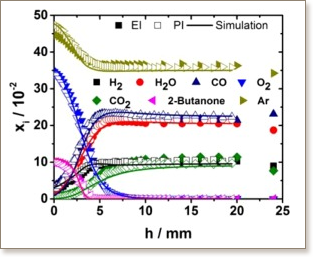A laminar flame investigation of 2-butanone, and the combustion-related intermediates formed through its oxidation


2-butanone (methyl ethyl ketone) is a recently identified high-octane, next-generation biofuel candidate, synthesized through microbiological pathways from biomass. Its high octane number (RON = 117), low boiling point (80 °C), and relatively high
vapor pressure (10.8 kPa at 20 °C) make 2-butanone a potentially good candidate for use in spark-ignition engines. The flame structure and species formed in 2-butanone combustion are of interest when further considering this compound for use as
a fuel. To this end, the present study has, for the first time, quantitatively measured species profiles within a fuel-rich (ϕ = 1.6) laminar premixed flat flame of 2-butanone. Two experiments which used different facilities and measurement techniques
were combined to provide a cross comparison of the measured species. One experiment was performed using electron ionization (EI) molecular-beam mass spectrometry (MBMS), and the second relied on synchrotron-generated vacuum ultraviolet (VUV) photoionization
(PI) MBMS. Quantitative mole fraction profiles for about 45 species were obtained from the two independent experiments that are found to be in good agreement. The experiments have identified the formation of a number of toxic oxygenated intermediates,
such as methyl vinyl ketone (MVK), acetaldehyde, and formaldehyde. In addition, the measurements have also provided quantitative species profiles for a number of soot precursor species, the concentrations of which are notably low.
These measurements provide useful validation targets for the further development of detailed chemical kinetic models. As a first test, an existing 2-butanone model was examined against the experimental data with the main aim to identify elements of the model that may need improvement.

"KAUST shall be a beacon for peace, hope and reconciliation, and shall serve the people of the Kingdom and the world."
King Abdullah bin Abdulaziz Al Saud, 1924 – 2015
Thuwal 23955-6900, Kingdom of Saudi Arabia
© King Abdullah University of Science and Technology. All rights reserved